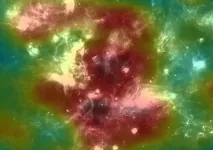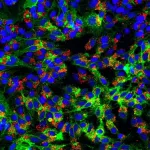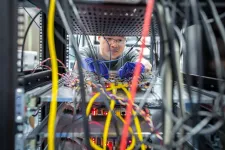(Press-News.org) For the first time ever, a Northwestern University-led research team has peered inside a human cell to view a multi-subunit machine responsible for regulating gene expression.
Called the Mediator-bound pre-initiation complex (Med-PIC), the structure is a key player in determining which genes are activated and which are suppressed. Mediator helps position the rest of the complex -- RNA polymerase II and the general transcription factors -- at the beginning of genes that the cell wants to transcribe.
The researchers visualized the complex in high resolution using cryogenic electron microscopy (cryo-EM), enabling them to better understand how it works. Because this complex plays a role in many diseases, including cancer, neurodegenerative diseases, HIV and metabolic disorders, researchers' new understanding of its structure could potentially be leveraged to treat disease.
"This machine is so basic to every branch of modern molecular biology in the context of gene expression," said Northwestern's Yuan He, senior author of the study. "Visualizing the structure in 3D will help us answer basic biological questions, such as how DNA is copied to RNA."
"Seeing this structure allows us to understand how it works," added Ryan Abdella, the paper's co-first author. "It's like taking apart a common household appliance to see how everything fits together. Now we can understand how the proteins in the complex come together to perform their function."
The study will be published March 11 in the journal Science. This marks the first time the human Mediator complex has been visualized in 3D in the human cell.
He is an assistant professor of molecular biosciences in Northwestern's Weinberg College of Arts and Sciences. Abdella and Anna Talyzina, both graduate students in the He lab, are co-first authors of the paper.
Famed biochemist Roger Kornberg discovered the Mediator complex in yeast in 1990, a project for which he won the 2006 Nobel Prize in Chemistry. But Mediator comprises a daunting 26 subunits -- 56 total when combined with the pre-initiation complex -- it's taken researchers until now to obtain high-resolution images of the human version.
"It's a technically quite challenging project," He said. "These complexes are scarce. It takes hundreds of liters of human cells, which are very hard to grow, to obtain small amounts of the protein complexes."
A breakthrough came when He's team put the sample on a single layer of graphene oxide. By providing this support, the graphene sheet minimized the amount of sample needed for imaging. And compared to the typical support used -- amorphous carbon -- graphene improved the signal-to-noise ratio for higher-resolution imaging.
After preparing the sample, the team used cryo-EM, a relatively new technique that won the 2017 Nobel Prize in Chemistry, to determine the 3D shape of proteins, which are often thousands of times smaller than the width of a human hair. The technique works by blasting a stream of electrons at a flash-frozen sample to take many 2D images.
For this study, He's team captured hundreds of thousands of images of the Med-PIC complex. They then used computational methods to reconstruct a 3D image.
"Solving this complex was like assembling a puzzle," Talyzina said. "Some of those subunits were already known from other experiments, but we had no idea how the pieces assembled together or interacted with each other. With our final structure, we were finally able to see this whole complex and understand its organization."
The resulting image shows the Med-PIC complex as a flat, elongated structure, measuring 45 nanometers in length. The researchers also were surprised to discover that the Mediator moves relative to the rest of the complex, binding to RNA polymerase II at a hinge point.
"Mediator moves like a pendulum," Abdella said. "Next, we want to understand what this flexibility means. We think it might have an impact on the activity of a key enzyme within the complex."
INFORMATION:
The paper, "Structure of the human Mediator-bound transcription pre-initiation complex," was supported by Northwestern's Chemistry of Life Sciences Institute, the Chicago Biomedical Consortium with support from the Searle Funds at The Chicago Community Trust, the American Cancer Society (award number IRG-15-173-21), the H Foundation (award number U54-CA193419) and the National Institutes of Health (award numbers R01-GM135651 and P01-CA092584).
Magnetic resonance imaging (MRI) is already widely used in medicine for diagnostic purposes. Hyperpolarized MRI is a more recent development and its research and application potential has yet to be fully explored. Researchers at Johannes Gutenberg University Mainz (JGU) and the Helmholtz Institute Mainz (HIM) have now unveiled a new technique for observing metabolic processes in the body. Their singlet-contrast MRI method employs easily-produced parahydrogen to track biochemical processes in real time. The results of their work have been published in Angewandte ...
At the heart of Cygnus, one of the most beautiful constellations of the summer sky, beats a source of high-energy cosmic ray particles: the Cygnus Cocoon. An international group of scientists at the HAWC observatory has gathered evidence that this vast astronomical structure is the most powerful of our galaxy's natural particle accelerators known of up to now.
This spectacular discovery is the result of the work of scientists from the international High-Altitude Water Cherenkov (HAWC) gamma-ray observatory. Located on the slopes of the Mexican Sierra Negra volcano, the observatory records high-energy particles and photons flowing from the abyss of space. In the sky of the Northern Hemisphere, their brightest source is the region known as the Cygnus Cocoon. At the HAWC, it was established ...
Geologists have long thought tectonic plates move because they are pulled by the weight of their sinking portions and that an underlying, hot, softer layer called asthenosphere serves as a passive lubricant. But a team of geologists at the University of Houston has found that layer is actually flowing vigorously, moving fast enough to drive plate motions.
In their study published in Nature Communications, researchers from the UH College of Natural Sciences and Mathematics looked at minute changes in satellite-detected gravitational pull within the Caribbean and at mantle tomography images - similar to a CAT Scan - of the asthenosphere under the Caribbean. They found ...
Alexandria, Va., USA -- Oral mucositis and taste dysfunction (dysgeusia) occurs in nearly all patients receiving head and neck radiotherapy and tremendously affects the quality of life and treatment outcome. The study "LiCl Promotes Recovery of Radiation-Induced Oral Mucositis and Dysgeusia" published in the Journal of Dental Research (JDR), investigated the hypothesis that lithium chloride (LiCl) can promote the restoration of oral mucosa integrity and taste function after radiation.
LiCl is a potent activator of a key cell signaling pathway called Wnt/β-catenin that is critical for the development, regeneration and function of many tissue types. ...
BUFFALO, N.Y. - A University at Buffalo researcher's recent work on dyslexia has unexpectedly produced a startling discovery which clearly demonstrates how the cooperative areas of the brain responsible for reading skill are also at work during apparently unrelated activities, such as multiplication.
Though the division between literacy and math is commonly reflected in the division between the arts and sciences, the findings suggest that reading, writing and arithmetic, the foundational skills informally identified as the three Rs, might actually overlap in ways not previously imagined, let alone experimentally validated.
"These findings floored me," said Christopher McNorgan, PhD, the paper's author and an assistant professor in UB's Department of Psychology. "They elevate the ...
Researchers at Princeton have determined how five cellular proteins contribute to an essential step in the life cycle of hepatitis B virus (HBV). The article describing these findings appeared March 11, 2021 in the journal Nature Communications.
Viruses have been with us, shaping our lives, societies and economies for millennia. While some viruses rapidly explode onto the world stage, others smolder in our communities for decades, shattering lives but making few headlines. Hepatitis B virus hasn't caused any nationwide lockdowns or stock market crashes because it is slow to spread from person to person and is rarely immediately fatal. It is nonetheless incredibly damaging because it can establish lifelong chronic infection ...
RESEARCH TRIANGLE PARK, N.C. -- New Army-funded research could help lay the groundwork for future quantum communication networks and large-scale quantum computers.
Researchers sent entangled qubit states through a communication cable linking one quantum network node to a second node.
Scientists at the Pritzker School of Molecular Engineering at the University of Chicago, funded and managed by the U.S. Army Combat Capability Development, known as DEVCOM, Army Research Laboratory's Center for Distributed Quantum Information, also amplified an entangled state via the same cable first by using the cable to entangle two qubits in each of two nodes, then entangling these qubits further with other qubits in the nodes. The peer-reviewed journal ...
Atherosclerosis is the underlying condition that causes heart attacks and strokes. Researchers at Radboudumc in the Netherlands have discovered a protein that appears to play an important role in atherosclerosis. The protein is called Prosaposin, and its role in atherosclerosis was sofar unknown. "We identified Prosaposin as a new potential target for the Science Translational Medicine.
Atherosclerosis is caused by cholesterol that builds up in the vessel wall and triggers chronic inflammation. It has been well established that cholesterol lowering drugs help to treat atherosclerosis. Recent research has shown that inhibiting inflammation can also help to prevent heart attacks and ...
What The Study Did: In this phase 1 study, a single immunization with Ad26.COV2.S (Janssen/Johnson & Johnson) vaccine induced rapid binding and neutralization antibody responses as well as cellular immune responses. Two phase 3 clinical trials are currently underway to determine the efficacy of the Ad26.COV2.S vaccine.
Authors: Dan H. Barouch, M.D., Ph.D., of Beth Israel Deaconess Medical Center in Boston, is the corresponding author.
To access the embargoed study: Visit our For The Media website at this link https://media.jamanetwork.com/
(doi:10.1001/jama.2021.3645)
Editor's Note: Please see the article ...
Does a warmer climate mean more dry land? For years, researchers projected that drylands -- including deserts, savannas and shrublands -- will expand as the planet warms, but new research from the Harvard John A. Paulson School of Engineering and Applied Sciences (SEAS) challenges those prevailing views.
Previous studies used atmospheric information, including rainfall and temperature, to make projections about future land conditions. The real picture is more complicated than that, said Kaighin McColl, Assistant Professor of Earth and Planetary Sciences and of Environmental Science and Engineering at SEAS and senior author ...



